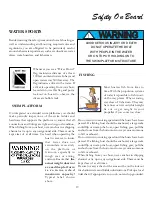
7
Safety On Board
U. S. Coast Guard approved fire extinguishers are required
on all Regal boats. Besides the
minimum
Coast Guard
requirements always check state and local agencies for
additional requirements and equipment.
Coast Guard approved extinguishers are hand-portable,
either B-I or B-II classification. U. S. Coast Guard approved
hand-portable and semi-portable extinguishers contain a
metal plate that shows the manufacturers name and
extinguisher type, capacity and opearting instructions. They
have a special marine type mounting bracket which keeps
the extinguisher solidly mounted until needed. The
extinguisher needs to be mounted in a readily accessible
location but one out of being bumped by people while
underway. All approved extinguishers need to have an
indication gauge.
USCG APPROVED FIRE EXTINGUISHER
TYPES & FEATURES
The dry chemical agent is widely
used because of its convenience and
low cost. The extinguisher canister
is filled with a white dry chemical
power along with a pressurized gas.
It is a good idea to shake this type
periodically because they tend to
“pack” on the canister bottom.
The foam type uses a chemical
foaming agent plus water and is best
when used for fires involving
flammable liquids- solvents, gasoline,
oil, grease and various paints. It will
work on fires involving rubber,
plastics, cloth, wood, and paper. It
leaves a messy residue. Do not use this
extinguisher for electric fires.
The carbon dioxide unit uses
CO2 gas under high pressure, with a
funnel discharge hoseusually swivel
mounted. This extinguisher leaves no
residue and does not cause interior
engine harm. To ensure workability,
weigh the unit annually. A 10%
maximum weight variance is allowed.
Another type is liquified gas. This gas is colorless and
odorless, heavier than air and sinks to the lower bilge to
extinguish fires. Since the year 2000 ingredients for liquid
gas has changed to a more environmental friendly formula.
Liquid gas is used in portable-hand units along with making
up the majority of boat automatic fire extinguishing
systems. The canister needs to be weighed once a year.
Liquid gas units must feature a dash mount indicator.
Refer to the information regarding fire prevention in this manual.
VISUAL DISTRESS SIGNALS
All vessels used on coastal waters, any of the Great Lakes,
territorial seas, and those waters connected directly to them
up to point where a body of water is less than two miles
wide, must have Coast Guard approved visual distress
signals.
Summary of Contents for 30 EXPRESS
Page 1: ...30 EXPRESS OWNER S MANUAL...
Page 2: ...784022 OWNER S MANUAL 30 EXPRESS 12 2012...
Page 30: ...11 Safety On Board NAVIGATION LIGHT RULES...
Page 41: ...Chapter 2 22 Notes...
Page 44: ...3 Rules Of The Road NAVIGATION RULES...
Page 85: ...28 Chapter 5 Notes...
Page 105: ...4 Chapter 7...
Page 106: ...5 Equipment Operation...
Page 107: ...6 Chapter 7...
Page 108: ...7 Equipment Operation...
Page 109: ...8 Chapter 7...
Page 110: ...9 Equipment Operation...
Page 111: ...10 Chapter 7...
Page 117: ...16 Chapter 7...
Page 126: ...25 Equipment Operation ROTARY ENCODER AND MENU KEY...
Page 127: ...26 Chapter 7 USING THE ROTARY ENCODER AND MENU KEY...
Page 158: ...57 Equipment Operation BACKING A TRAILER 1 2 3 4 LAUNCHING RAMP...
Page 161: ...60 Chapter 7 Notes...
Page 195: ...34 Chapter 8 Notes...
Page 204: ...9 Troubleshooting TOILET SYSTEM DIAGNOSTIC CHART...
Page 209: ...14 Chapter 9...
Page 219: ...6 Chapter 11 Notes...
Page 221: ...2 Chapter 12...
Page 224: ...5 Technical Information 30 Express Deck Overview 30 Express Cabin Overview...
Page 225: ...Technical Information 12 6 30 EXPRESS...
Page 226: ...12 7 Technical Information 30 EXPRESS...
Page 227: ...Technical Information 12 8 30 EXPRESS...
Page 228: ...12 9 Technical Information 30 EXPRESS...
Page 229: ...Technical Information 12 10 30 EXPRESS 30 EXPRESS...
Page 230: ...12 11 Technical Information TYPICAL NEGATIVE GROUND SYSTEM...
Page 231: ...Technical Information 12 12 30 EXPRESS...
Page 232: ...12 13 Technical Information 30 EXPRESS...
















































